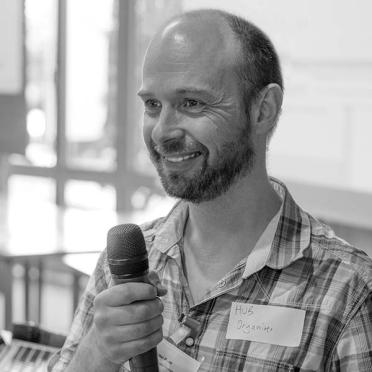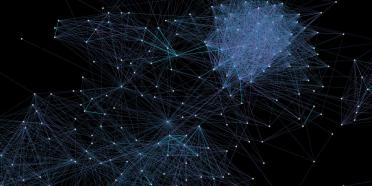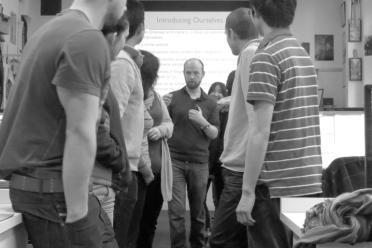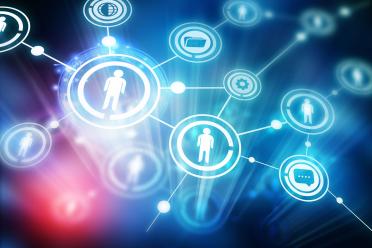Stronger together: building scientific communities
Aiming to reach new heights with its bioinformatics tools for signalling networks and large-scale integrated analysis, SignaLink and NavigOmix, the Korcsmaros Group has a new addition.

EI's new Senior Community and Business Development Manager for SignaLink and NavigOmix.
Credit: Matthew Betts
Aiming to reach new heights with its bioinformatics tools for signalling networks and large-scale integrated analysis, SignaLink and NavigOmix, the Korcsmaros Group has a new addition. Aidan Budd tells us how he got into building successful scientific communities and his new role at EI — with caffeine proven as a key contributor!
Before taking this position I had visited the EI (then TGAC) four times, where I co-organised an EMBO-funded bioinformatics practical course in autumn 2015, which my new EI line manager (Tamás Korcsmáros) also co-organised. I also co-organised a User Experience (UX) Workshop here at EI in spring 2015 (the photo on that page has my bald head bottom left!), participated in the 2013 ELIXIR-UK/GOBLET workshop in March 2013 and the GOBLET AGM in November 2013.
The people at the Institute were always very welcoming and helpful, and I liked the building, the location, and Norwich itself. In particular, I love the old streets and medium-sized city feel of Norwich — and as I enjoy history, art, real ale, and exotic beer, Norwich has lots of things for me to enjoy!
I'm also very enthusiastic about Open Science (or as I like to think of it "what I always thought science was supposed to be anyway" — sometimes I wish that what we refer to as "Open Science" was called just "Science" and non-open science was referred to as "Closed Science"!) — EI's focus on, and commitment to, Open Science is another reason I was keen to work there.
More specifically, it’s great working with Tamás Korcsmáros at the EI. Tamas and I have known each other for around four years, and I've always enjoyed talking to, and working with him. We've many overlapping enthusiasms and interests, and I'm sure we're going to get some brilliant work done together!
Starting with my PhD, I worked for ten years in bioinformatics research at the European Molecular Biology Laboratory, EMBL, in Heidelberg, in the group of Toby Gibson — with a year’s break as a book commissioning editor for Wiley-VCH. During this time, I found that I was becoming more interested in how to organise, promote, fund, and facilitate the scientific endeavour, rather than in carrying out the research myself. Thus, five years ago, still working with Toby, my focus shifted towards managing and delivering projects linked to community building and training for bioinformatics.
At EMBL Heidelberg, I managed a project to build a stronger community and shared resources for their bioinformatics research. I hugely enjoyed bringing people together; helping them find out what they wanted to do together to improve their situation; and then to help them achieving these things together. For example, through this work, the bioinformatics community at EMBL now organises and delivers regular courses on a range of topics to help EMBL scientists gain the IT and bioinformatics skills they need to get the most out of their data.
I was also involved in organising and delivering a range of unconference, conference, and workshop sessions on the topic of scientific community building — resulting in a collaborative article in PLOS Computational Biology about building successful bioinformatics communities.
I'm really looking forward, in my work at the EI, to continuing my focus on community building in the sciences in a new context, with different goals and approaches.
The two main projects I'll be working on at the EI are both bioinformatics tools developed in the Korcsmaros Group: SignaLink and NavigOmix.
SignaLink is a free resource that focuses on providing scientists with manually curated information about signalling networks in model organisms. It also integrates information on interactions between many different aspects of these networks (transcription factors (TFs), TF binding sites in DNA, miRNAs, directed protein-protein interactions, and more). Among other things, SignaLink is designed to provide insights into cross-talk between different signalling pathways, to provide a holistic, integrated, multi-scale overview of information about signalling stored across many diverse data sources.
Through an open, interactive website, SignaLink makes it easy for scientists to explore this network in specific detail — while also providing systems biologists and bioinformaticians access to easy-to-download large datasets for use in modelling and further bioinformatics analysis of high-quality curated data about cellular signalling.
SignaLink is about to go through a big upgrade. The current version, SignaLink 2.0 was published in 2013. SignaLink 3.0 will be released later this year, with a completely updated backend and frontend architecture, and including several new ways of looking at the data, including regulation at the subcellular localisation and tissue level, and including interactions with long non-coding RNAs (lncRNAs).
Several key online bioinformatics resources, for example, UniProt and FlyBase, provide direct links to SignaLink data — the SignaLink tool is known as one of the key resources for integrated data on signalling in model organisms. Part of my job at EI will be to increase awareness of how the tool can assist researchers in their work, and to build engagement and collaboration with this audience as we move to SignaLink 3.0, and look forward to SignaLink 4.0 — and to help bring in the extra funding needed to support these developments.

I found that I was becoming more interested in how to organise, promote, fund, and facilitate the scientific endeavour, rather than in carrying out the research myself.

NavigOmix aims to help scientists working on large-scale integrated bioinformatics analyses. The project earlier received support from the Norwich Research Park Translation Fund (when TGAC). These days, more than half of the time spent on data-driven projects involves simply managing data — integrating, transforming, and cleansing it — before any actual analysis can begin. NavigOmix aims to significantly reduce this time for scientists working with many different kinds of biological data by providing advanced visualisation, multi-layered databases, data integration and evaluation solutions, and network analytical tools.
NavigOmix is still under development, and a key feature of the tool is that it will be highly scalable i.e. it will be easy to move from analysing a relatively small dataset, to working with much larger ones, by harnessing cloud resources. Due to the potentially huge computing resources such scaling-up may require, we expect we will need to charge users for carrying out larger, more complex, more computationally intensive analyses using NavigOmix.
It will be great to work with the NavigOmix team bringing in the funding needed to take it to the next level of development — putting the resources needed for high-powered, complex, integrated bioinformatics analyses into the hands of the bench scientists. I'm particularly looking forward to working with NavigOmix users to make it, with them, one of the first-choice options for complex data analysis and visualisation challenges.

SignaLink’s novel, multi-layered (onion-like) database structure is made up of signalling pathways, their pathway regulators (e.g., scaffold and endocytotic proteins) and modifier enzymes (e.g. phosphatases, ubiquitin ligases), as well as transcriptional and post-transcriptional regulators of all of these components. The user-friendly website allows the interactive exploration of how each signalling protein is regulated. The customisable download page enables the analysis of any user-specified part of the signalling network.
The ‘business development’ part of the role will focus on securing additional financial support for the development of both SignaLink and NavigOmix. I've previously organised or co-organised successful applications for funds to run a range of bioinformatics-focused events (funding or support from the EU, EMBO, the Wellcome Trust, ISCB, BOSC, and ESOF), and I'm excited to start using this experience for securing funding for the development of specific software tools and related research infrastructure.
The ‘community management’ part of the role will focus on working closely with NavigOmix and SignaLink users; to support the growth of a healthy user community around the tools. Most of my community development work has focused on communities with a large face-to-face component, something Lou Woodley might classify as ‘communities of place’. For example, my work with the community associated with the Heidelberg Unseminars in Bioinformatics (HUB) e.V. organisation, that I'm a co-founder and currently Chair of, which has organised more than 25 events since starting up in 2012. There has always been a virtual/electronic component to my work with these communities, and it will be really interesting to take on a role that will have a wider focus on working with people in this context.

All effective communities (communities that people enjoy being a part of, and which are effective at achieving the shared collaborative aims of their members) require and depend on a mutual feeling of trust and belonging. When we are talking and working together with a group of people with whom we share many common values, goals, and interests and who enjoy working with others then it is amazing what can be achieved together. Often, and most excitingly, what you then achieve is something that would probably not have been done if people hadn't chosen to come together.
Thus, in my work with the EI, I'll be focusing on making communication with the users of the SignaLink and NavigOmix tools open, clear, transparent, respectful, and effective. We'll also look for opportunities for users, and other stakeholders, to link-up to better understand, together, our common goals, interests, and values.
Another tool I've found really effective for community building in academia is crowdsourcing the writing of opinion articles. We've published two of those, one in EMBO Reports, and another in PLOS Computational Biology, and have found them a great tool for bringing people together around a topic of shared interest, and to collaborate together to produce something tangible and valuable for them and others. If you're interested in trying this out yourself sometime, check out this interview where I describe some do's and don't's of writing opinion articles in this way.
And, of course, the vital ingredient for most scientists — coffee! See my speculations on the correlation between caffeine hits and scientific output, from my musings on Twitter … http://news.embl.de/lab-matters/40-questions-answered/.

1. Facilitate development of trusting, high-quality relationships
2. Give the community the power to make happen what they want to happen
3. Trust the community; trust them to want to make good things (for you and them) happen
1. A strong commitment to clear transparent respectful effective open communication
2. Providing contexts for people to get in touch and find their common interests, goals, and values
3. Making a clear link between the opinions and suggestions of users, and the way the tools are developed i.e. empowering the users
I'm not a particularly proud person, so this is a hard one for me to answer.
It's easier for me to think about the projects I've enjoyed, and got great satisfaction, from working on.
In that case, I'll go for our project to build a greater sense of community amongst people interested in bioinformatics and science communication around Heidelberg.
In 2012, as part of my job building community amongst bioinformaticians at EMBL in Heidelberg, I was encouraged to start trying to do the same thing in the local area, with people interested in bioinformatics from the various life-science organisations nearby.
Rather than doing this with the traditional ‘research seminars in the evenings with food and drink’, together with two friends (Matthew Betts and Katja Linssen), we decided to try instead using 'unseminar' events.*
As a result of coming together with Matthew, Katja, and many others in and around Heidelberg, this project has been so much more successful than we ever expected! The 24th local Heidelberg Unseminar in Bioinformatics runs soon. We've run unseminars in Cape Town, Norwich and Budapest, and have organised 'unconference' sessions at conferences in Berlin, Dublin, and Copenhagen.
Inspired by the Heidelberg Unseminars, people have tried them out, independently from us, in Wuertzburg (Germany) and Cape Town. We've had lots of fun, have gotten to know each other much better than before, and have seen the events lead to many valuable, long-lasting collaborations — indeed, the person who took over my position at EMBL when I left there to join the EI is someone (the excellent Malvika Sharan) who I met through this work.
Aidan Budd joined the Korcsmaros Group on 17 August 2016.
If you're interested in hearing more about scientific community building, check out these slides Aidan used for presenting the topic, or his interview by Trellis (AAAS's new digital communication and collaboration platform, currently in beta) about his community work.
* Unseminars are small versions of unconferences — where unconferences are like conferences — events that bring together groups of people around a common interest — but also unlike conferences, in the way they can flip common features of conferences, for example, allowing all participants to have similar influence on the event programme; shifting away from transmissive communication towards small-group discussions, and a general attitude of informality rather than formality.